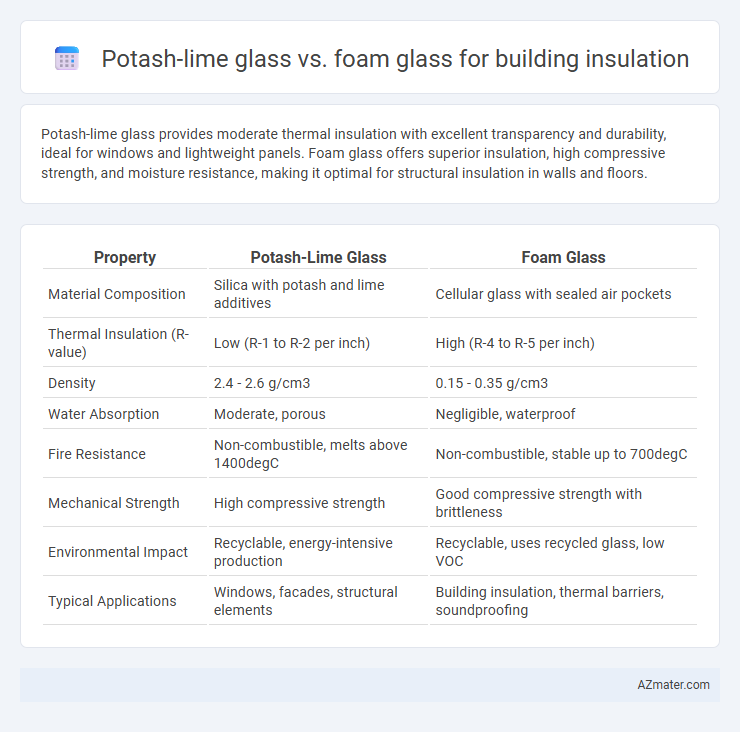Potash-lime glass provides moderate thermal insulation with excellent transparency and durability, ideal for windows and lightweight panels. Foam glass offers superior insulation, high compressive strength, and moisture resistance, making it optimal for structural insulation in walls and floors.
Table of Comparison
| Property | Potash-Lime Glass | Foam Glass |
|---|---|---|
| Material Composition | Silica with potash and lime additives | Cellular glass with sealed air pockets |
| Thermal Insulation (R-value) | Low (R-1 to R-2 per inch) | High (R-4 to R-5 per inch) |
| Density | 2.4 - 2.6 g/cm3 | 0.15 - 0.35 g/cm3 |
| Water Absorption | Moderate, porous | Negligible, waterproof |
| Fire Resistance | Non-combustible, melts above 1400degC | Non-combustible, stable up to 700degC |
| Mechanical Strength | High compressive strength | Good compressive strength with brittleness |
| Environmental Impact | Recyclable, energy-intensive production | Recyclable, uses recycled glass, low VOC |
| Typical Applications | Windows, facades, structural elements | Building insulation, thermal barriers, soundproofing |
Introduction to Potash-Lime Glass and Foam Glass
Potash-lime glass, composed primarily of silica, potash (K2O), and lime (CaO), offers excellent thermal insulation properties and durability for building applications. Foam glass, made by foaming crushed glass with a foaming agent, provides superior insulation through its closed-cell structure, combining lightweight nature with high compressive strength. Both materials enhance energy efficiency in buildings, but foam glass typically delivers better moisture resistance and fire retardancy compared to potash-lime glass.
Composition and Manufacturing Processes
Potash-lime glass is primarily composed of silica (SiO2), potash (K2O), and lime (CaO), produced through melting raw materials at high temperatures followed by controlled cooling. Foam glass insulation is manufactured by crushing recycled glass, mixing with a foaming agent like carbon or manganese dioxide, and heating in a furnace to create a porous, lightweight structure. While potash-lime glass results from melting and shaping processes, foam glass involves foaming techniques to achieve superior thermal insulation and compressive strength for building applications.
Thermal Insulation Properties
Potash-lime glass typically exhibits moderate thermal insulation properties with a thermal conductivity ranging from 0.7 to 1.0 W/m*K, making it less effective compared to foam glass. Foam glass insulation offers superior thermal resistance, with thermal conductivity values as low as 0.05 W/m*K, due to its closed-cell structure that minimizes heat transfer. This significant difference in thermal insulation efficiency makes foam glass a preferred choice for energy-saving building applications where enhanced thermal performance is critical.
Mechanical Strength and Durability
Potash-lime glass, commonly used in residential construction, offers moderate mechanical strength and reasonable durability but is less resistant to impact and long-term moisture exposure compared to foam glass. Foam glass, a cellular glass insulation material, exhibits superior compressive strength and exceptional durability against moisture, chemicals, and fire, making it ideal for demanding building insulation applications. Its closed-cell structure provides enhanced mechanical robustness and longevity, outperforming potash-lime glass in terms of insulation stability and structural integrity over time.
Moisture Resistance and Water Absorption
Potash-lime glass exhibits moderate moisture resistance but tends to have higher water absorption rates compared to foam glass, making it less ideal for high-humidity environments. Foam glass boasts exceptional moisture resistance due to its closed-cell structure, resulting in near-zero water absorption and superior insulating performance in damp conditions. This distinct advantage allows foam glass to maintain thermal integrity and structural durability over time, outperforming potash-lime glass in building insulation applications where moisture exposure is a concern.
Fire Resistance and Safety Features
Potash-lime glass insulation offers moderate fire resistance but tends to soften at lower temperatures compared to foam glass, which exhibits superior fire resistance due to its non-combustible closed-cell structure that withstands temperatures above 1000degC. Foam glass provides enhanced fire safety features, including low smoke emission and non-toxic byproducts during combustion, making it ideal for high-risk fire environments. The high compressive strength and dimensional stability of foam glass further contribute to its effectiveness in fire-resistant building insulation applications.
Sustainability and Environmental Impact
Potash-lime glass insulation offers moderate sustainability due to lower energy consumption during production and recyclability, but it has a higher embodied carbon compared to foam glass. Foam glass insulation excels in environmental impact by utilizing recycled glass, providing excellent durability, and offering superior thermal insulation, which reduces overall energy use in buildings. Both materials contribute to sustainable building practices, but foam glass stands out for its lower environmental footprint and longer lifecycle.
Cost Effectiveness and Availability
Potash-lime glass insulation generally offers higher cost-effectiveness due to its widespread availability and lower production costs, making it a preferred choice for budget-conscious building projects. Foam glass, while providing superior thermal insulation and moisture resistance, tends to be more expensive and less readily available due to specialized manufacturing processes. The decision between the two materials largely depends on balancing upfront insulation performance against budget constraints and local market supply.
Installation and Application Methods
Potash-lime glass insulation is typically installed in loose-fill or granular form, making it suitable for casting into cavities or mixing with binders for spray applications, which requires careful moisture control during installation. Foam glass insulation is manufactured as rigid blocks or slabs, allowing for precise cutting and fitting in walls, floors, and roofs, with installation methods that emphasize adhesive bonding or mechanical fastening to structural elements. Both materials demand adherence to specific handling procedures to maintain their thermal performance and structural integrity during application in building insulation projects.
Suitability for Modern Building Insulation
Potash-lime glass, known for its clarity and chemical resistance, is less effective as an insulator due to its relatively high thermal conductivity compared to foam glass, which offers superior thermal insulation and moisture resistance. Foam glass, composed of recycled glass with a closed-cell foam structure, is highly suitable for modern building insulation, providing excellent durability, fire resistance, and vapor impermeability. Its lightweight nature and environmentally friendly composition make foam glass the preferred choice for sustainable, energy-efficient building designs.

Infographic: Potash-lime glass vs Foam glass for Building insulation
 azmater.com
azmater.com